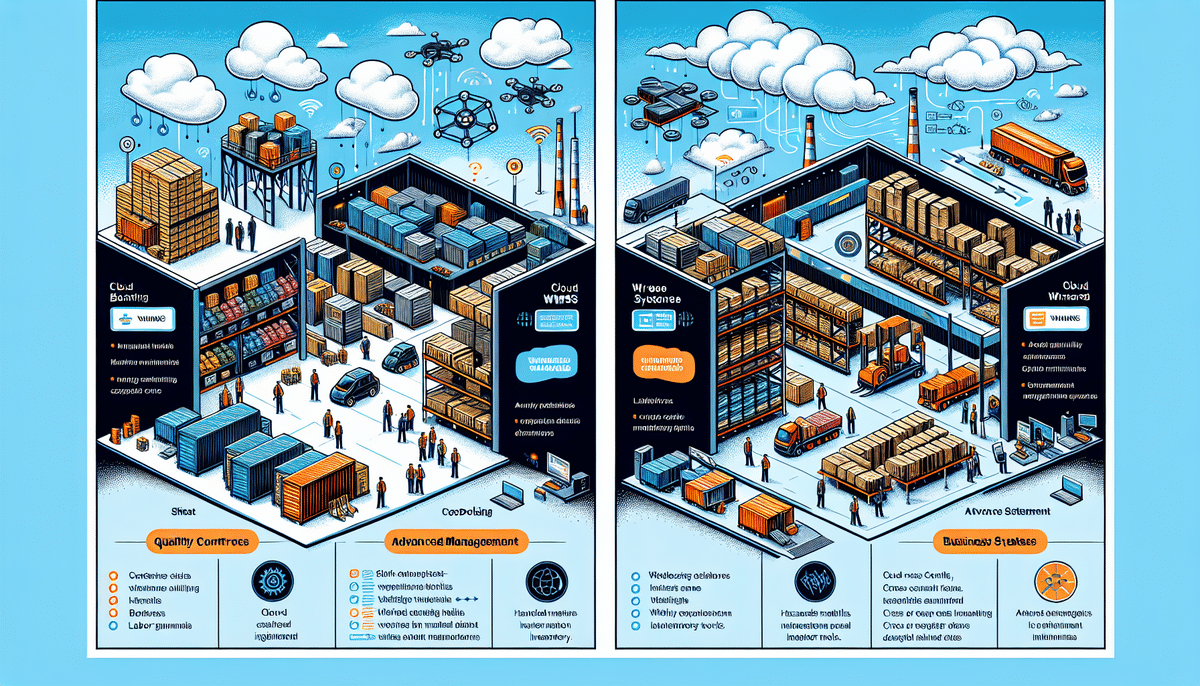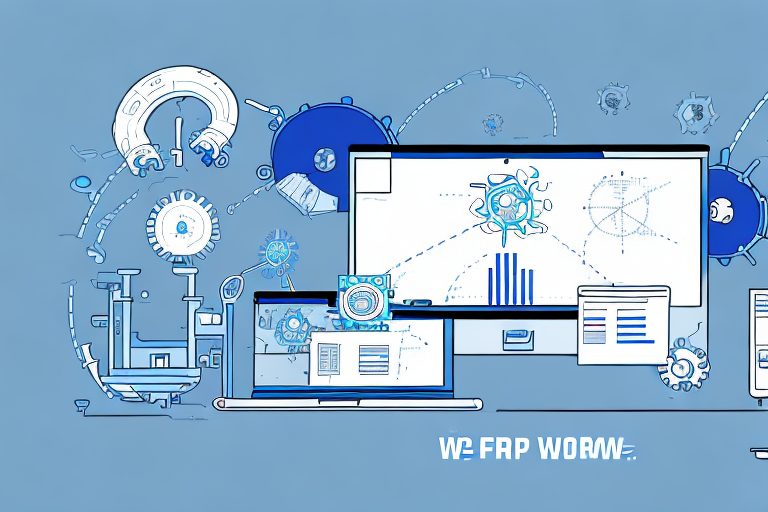NetSuite WMS vs SAP Extended Warehouse Management (EWM)
Are you searching for the optimal Warehouse Management System (WMS) for your business? NetSuite WMS and SAP Extended Warehouse Management (EWM) stand out as two leading solutions in the market. Selecting the right system can be challenging. This article offers a comprehensive overview of both platforms, highlights their key differences, and compares their features, pricing, implementation processes, integrations, and user experiences. We also delve into user reviews and provide guidance on determining which WMS best aligns with your business needs.
Overview of NetSuite WMS
NetSuite WMS is a cloud-based solution integrated within the broader NetSuite Enterprise Resource Planning (ERP) ecosystem. This warehouse management system is tailored for small to mid-sized businesses, offering robust inventory management capabilities. Key features include advanced coordination of shipping and receiving operations, wireless data capture support, and flexible receipt processing.
NetSuite WMS provides real-time visibility into inventory levels, enabling informed decisions regarding purchasing and restocking. It offers customizable reporting and analytics, offering insights into warehouse operations and identifying areas for improvement. By streamlining warehouse processes, NetSuite WMS enhances efficiency, leading to increased customer satisfaction and profitability.
Overview of SAP Extended Warehouse Management (EWM)
SAP EWM is a component of SAP's comprehensive supply chain management suite. This software delivers real-time visibility and control for optimizing warehouse operations. SAP EWM is highly customizable, supporting functionalities such as cross docking, slotting, and advanced shipping and receiving operations.
A significant advantage of SAP EWM is its seamless integration with other SAP solutions like SAP Transportation Management and SAP Global Trade Services. This integration enables end-to-end visibility and control over the entire supply chain, from inbound logistics to outbound delivery.
SAP EWM also boasts advanced analytics and reporting capabilities, allowing businesses to gain deep insights into their warehouse operations and make data-driven decisions. Features like real-time inventory tracking and automated replenishment help improve warehouse efficiency and reduce operational costs.
Key Differences between NetSuite WMS and SAP EWM
NetSuite WMS and SAP EWM cater to different market segments and business needs. NetSuite WMS is designed for small to mid-sized businesses seeking a comprehensive, all-in-one platform. In contrast, SAP EWM is engineered for large enterprises with complex warehouse operations requiring extensive customization.
Pricing models further distinguish the two systems. NetSuite WMS utilizes a subscription-based pricing structure that includes all features and updates within a single package. On the other hand, SAP EWM employs a more intricate pricing model that may involve additional costs for customization, implementation, and ongoing maintenance.
User experience also varies between the two. NetSuite WMS features a user-friendly interface and integrates effortlessly with other NetSuite products, such as ERP and CRM systems. SAP EWM, while offering a more powerful feature set, demands greater technical expertise and may require more extensive training for users to fully leverage its capabilities.
Comparative Analysis of NetSuite WMS and SAP EWM
Features
NetSuite WMS provides real-time stock visibility, automated picking and replenishment, wireless data capture, multi-location inventory management, and comprehensive shipping and fulfillment support. Its user-friendly interface and customizable dashboards facilitate easy tracking of inventory and operations.
SAP EWM offers a more extensive feature set, including cross-docking, slotting, receipts verification, advanced shipping and receiving operations, and support for third-party logistics providers (3PL). Additionally, SAP EWM excels in quality management and hazardous material handling, making it suitable for industries with stringent compliance requirements.
Pricing
NetSuite WMS pricing starts at approximately $999 per month for the base package, with potential increases based on customization needs. SAP EWM’s pricing is not publicly disclosed and typically requires a customized quote based on specific business requirements.
While NetSuite WMS offers a transparent, subscription-based pricing model, SAP EWM’s tailored pricing allows for greater flexibility but can result in higher and less predictable costs, especially for extensive customizations and implementations.
Implementation
NetSuite WMS, being a cloud-based solution, offers a streamlined implementation process without the need for significant hardware or software installations. This typically results in shorter deployment times and reduced upfront costs.
In contrast, SAP EWM often requires substantial hardware and software installations as part of its on-premise deployment model. The implementation process can span several months, depending on the complexity of the warehouse operations and the level of customization required.
Training is another consideration; NetSuite WMS’s intuitive interface simplifies the training process, whereas SAP EWM’s comprehensive feature set may necessitate more extensive training programs for staff.
Integrations
NetSuite WMS seamlessly integrates with other NetSuite products, including the ERP system and CRM. It also supports integrations with third-party applications such as ShipStation, SPS Commerce, and Celigo, enhancing operational efficiency through interconnected systems.
SAP EWM integrates effectively with various SAP solutions, including the SAP Business Suite, SAP Transportation Management, and SAP Global Trade Services. Additionally, it supports integrations with non-SAP systems like Microsoft Dynamics and Oracle ERP, providing flexibility for businesses with diverse software ecosystems.
User Experience
NetSuite WMS is lauded for its intuitive and user-friendly interface, which requires minimal training. Customizable dashboards allow users to monitor key performance indicators (KPIs) relevant to their roles.
SAP EWM, while offering a robust set of features, presents a steeper learning curve. Its dashboards are more complex, catering to users who need detailed and comprehensive data analysis. SAP EWM does not offer a dedicated mobile app, which may limit accessibility for users needing remote access.
The choice between the two often hinges on the specific needs and technical proficiency of the warehouse staff, with NetSuite WMS favoring ease of use and SAP EWM emphasizing depth and customization.
Pros and Cons
Pros and Cons of NetSuite WMS
Pros:
- Cloud-based solution for easy access and scalability
- Intuitive user interface simplifies training and adoption
- Comprehensive inventory management capabilities
- Seamless integration with NetSuite ERP and CRM systems
Cons:
- Customization can significantly increase costs
- Advanced features may require additional training
- Limited suitability for highly complex warehouse operations
Pros and Cons of SAP EWM
Pros:
- Highly customizable to meet specific business needs
- Advanced features like quality control and hazardous materials management
- Support for third-party logistics providers (3PL)
- Robust integration with other SAP solutions
Cons:
- On-premise solution requires significant upfront investment
- Implementation and maintenance can be costly and time-consuming
- Steep learning curve for users
Use Cases
When to Choose NetSuite WMS
NetSuite WMS is ideal for small to mid-sized businesses seeking a comprehensive inventory management solution without the complexity of extensive customization. It is well-suited for businesses transitioning to a cloud-based system and those with limited technical infrastructure. Companies that prioritize ease of use and quick deployment will find NetSuite WMS particularly beneficial.
When to Choose SAP EWM
SAP EWM is best suited for large enterprises with complex warehouse operations and specific management requirements. Businesses that handle hazardous materials, require stringent quality control, or engage with third-party logistics providers will benefit from SAP EWM’s advanced features. Additionally, organizations that already utilize other SAP solutions will find seamless integration advantageous.
User Reviews
What Do Businesses Say About NetSuite WMS?
Many businesses commend NetSuite WMS for its real-time inventory management and comprehensive dashboard reporting. Users appreciate the system’s ease of use and the ability to gain real-time visibility across the entire manufacturing and distribution process. However, some users have noted that customization can be expensive and may require significant time and resources to implement effectively.
What Do Businesses Say About SAP EWM?
Businesses praise SAP EWM for its extensive customization options and powerful real-time visibility and analytics, which aid in optimizing warehouse processes. The system's ability to handle complex operations and integrate with various SAP modules is highly valued. On the downside, users often mention that the implementation process is lengthy and requires substantial training, making the system more complex to use compared to other WMS solutions.
Conclusion: Which Warehouse Management System is Right for Your Business?
Selecting the appropriate WMS hinges on a strategic assessment of your business needs, budget, and technical infrastructure. NetSuite WMS offers a comprehensive, cloud-based inventory management solution with an intuitive user interface, making it an excellent choice for small to mid-sized businesses seeking ease of use and quick deployment. In contrast, SAP EWM provides advanced functionalities tailored for large enterprises with complex warehouse management requirements, including cross-docking, quality management, and hazardous materials handling.
Both systems feature robust integrations with other software solutions, enhancing overall operational efficiency. A thorough evaluation of their respective pros and cons will guide you in choosing the WMS that aligns best with your business objectives and operational complexities.




















